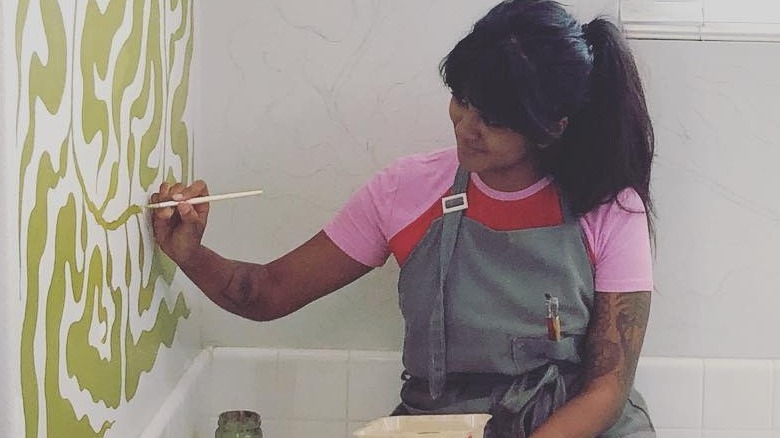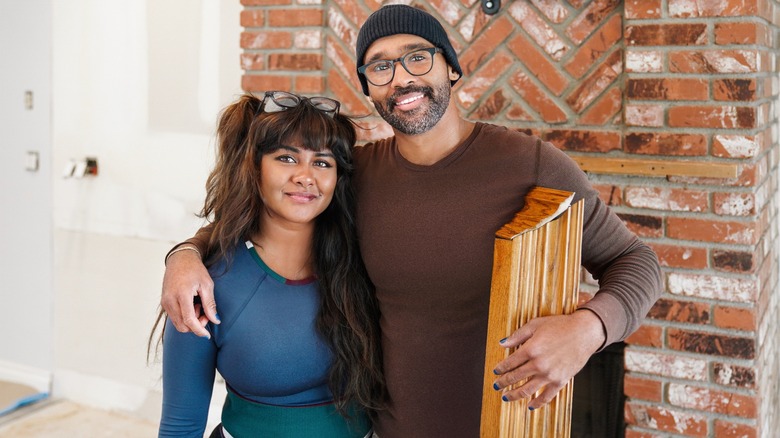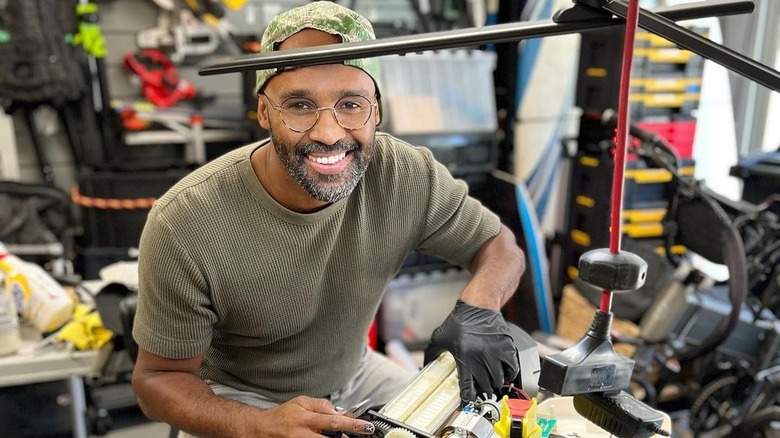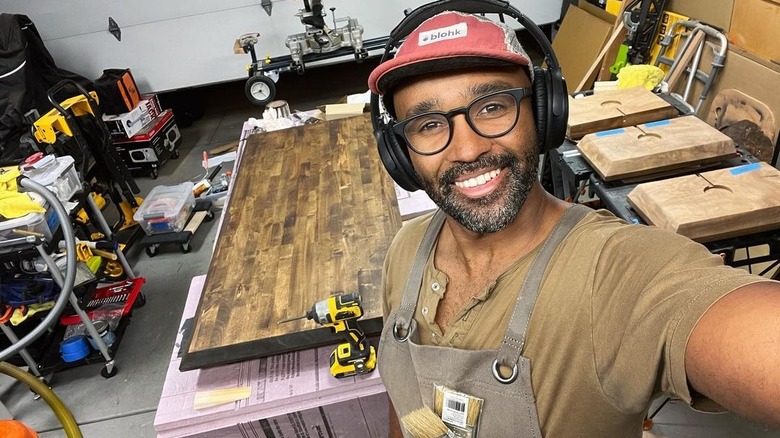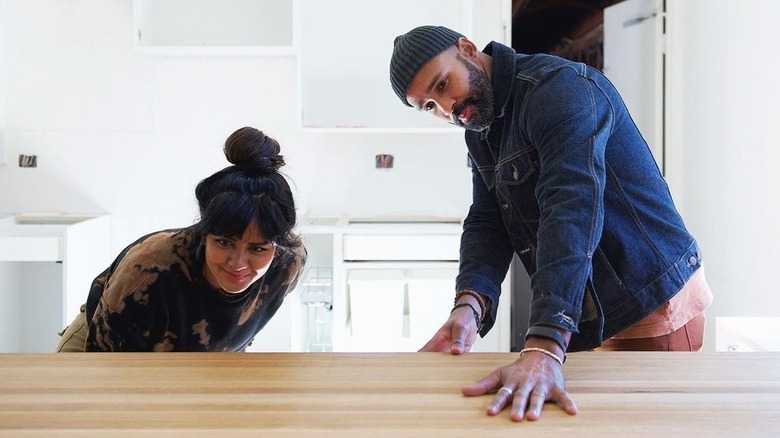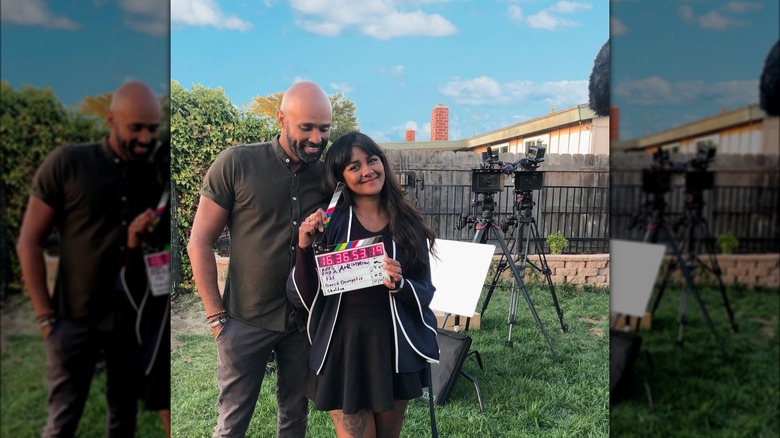HGTV's Raisa Kuddus & Austin Coleman On Their New Show First Home Fix - Exclusive Interview
For many first-time homebuyers, the biggest challenge is getting the most from a limited budget. This may mean settling for a less-than-perfect home — maybe one that's too small, oddly configured, or not quite to your taste — and setting aside part of your allotted funds to make it really look and feel like your own.
This, of course, is easier said than done. Noticing what you don't like about a home is simple. But figuring out the best way to fix it without spending too much can be tricky, especially if you have no experience in construction or design. This is where designer Raisa Kuddus and builder Austin Coleman come in. As both life and business partners, they collaborate to create spaces that truly reflect their clients' personalities and lifestyles. In their new HGTV show, "First Home Fix," they use their talents to help first-time homeowners seeking to create memorable spaces on fixed budgets. Kuddus and Coleman share their inspirations and tips in an exclusive interview with House Digest.
They build their creative processes around their clients
So I am curious to learn about your new show, "First Home Fix." Can you tell me a bit about how you got the idea for the show?
Austin Coleman: Well, we had a business working together, so we would describe it as a boutique real estate, design, and development business. And then some representatives of the network kind of floated into our wheelhouse, and everyone just kind of started collaborating together. So it was really more that we had a business in play, and the network ended up being able to chime in. And everyone's been working together for the last few years to build this concept out.
Raisa Kuddus: Yeah, we started off, the network kind of wanted us to go more beach-driven, but then they saw all of the skills that Austin and I had when it came to doing stuff ourselves, so we kind of tailored it more to be teaching clients how to do a lot of the stuff to save money.
Could you tell me a bit about your creative process? How do you and the homeowners you work with decide on which design ideas to use?
Kuddus: I think at first we started off with a creative brief where I asked them a lot of questions, not only about their home, but about their personalities. And those really intimate questions can help me figure out what kind of person they are, which helps me figure out what kind of design style they need. So then we work on mood boards, go back and forth, and then we all decide together that this is the direction we're heading towards, and that makes the whole process a lot easier.
Coleman: And usually in that process, we end up spending a lot of time with the clients, everyone, we get to learn their personalities, and that really helps a lot with the design, to really understand, because sometimes it's hard to understand what a client wants just from asking questions or having them fill out a questionnaire, and a lot is pulled from the social time and interaction we get to spend with them through the whole thing.
Kuddus: Yeah.
Balancing their relationship and business partnership has been an adventure
How long have you been working together, and what is it like for you two to work together?
Coleman: Well, we've been working together about five years, a little over five years. And what is it like working together? It's really nice, but it's like any relationship. Sometimes it's trying, and there are ups and downs, but I think we kind of pull from some of the core principles of our relationship, just having open communication. We always try to have fun, and that's kind of the basis of our relationship, so then we take that into our workspace. And we have this saying that we say to each other, anytime things are starting to get a little bit tumultuous, we say, "well, what are the chances we're going to have fun regardless?" And then the other will usually answer—
Kuddus: "A thousand percent!" But I also think we both have incredibly different perspectives from our different backgrounds, and that's something we really like in our relationship because we both have our own individual hobbies and passions, and it gives us a different look on every problem we come to, so that really helps just give us a rounded solution.
Coleman: Yeah, and I'm always mesmerized by your skillset, and I always can learn something from you.
Kuddus: Aw, vice versa.
Nice! So have you learned anything new about each other from working together?
Kuddus: I thought that I would be more of the dramatic one during filming, but I think Austin is.
Coleman: Oh, well you are 100% basing this on yesterday. Because yesterday, you killed it yesterday, and I was tired. And then, that's—
Kuddus: We were doing promo stuff. No, this was during filming. Everyone would be like, "Where's Austin?" And you would need some solitude time in the top of the van. We have a popup van, and you would need a—
Coleman: That's not drama, though.
Kuddus: That's not?
Coleman: That's removing myself from the drama, but somehow it comes off as dramatic.
Kuddus: But then the drama is everyone would be like, "Where's Austin? Where's Austin?" And I would have to find you.
Coleman: I'm not dealing with any of it.
Their hobbies and travel provide much of their design inspiration
So how would you describe your style, and who inspires you and your designs and your way of doing things?
Coleman: Well, I think a lot of our designs are definitely lifestyle oriented. We live and work in Southern California, and there's a lot to draw from, from the mountains to the beach. We spend a lot of time on the coast. I'm very active with what I think people describe as lifestyle sports, so there's a whole culture centered around surf culture and skate culture, like the sand and the water. And so I think just through that natural evolution, a lot of our style has been described as bohemian and eclectic, and that's really representative of the life we actually live.
Kuddus: And I also, but when it comes to our clients, we, again with those questionnaires and getting to know them, a lot of our design style is empathetic design where we do have more of a boho, eclectic style where it's based on our travels and memories of things we've done, but it's also largely based on nature. And when I get to know the clients, I figure out how we can weave our style and their style together.
What is it like designing and building on camera? Was that anything like you expected?
Kuddus: Designing on camera, some days were easier than others. If I'm doing a mural and they keep trying to pull me out for a scene, it was really hard to get out of my flow state. Because when I'm doing painting, I like to be really concentrated, and it's kind of hard to be pulled out of that a lot, but I've kind of figured it out.
Coleman: It's definitely challenging because we're having to service a whole new skillset while we're already fully immersed in our design or our build. I don't know. It was challenging, but like any skill set, the more you do it, the better you get at it, and so I think we found a really, really good balance.
Kuddus: And actually when we were filming someone, I think it was someone on the crew who was saying, "Well, if you get more seasons, you don't have to do all of this work." And I was like, "I always will want to do the work. Especially when it comes to my art."
Coleman: Right, right. I think that they're just saying you won't have time to do all of this stuff yourself because it'll be so busy, and your response to that was, "Well, I don't want to be doing it if I'm not doing it myself" because you want it to be representative of you and your work. But we take that to heart. If we put our name on something, we really want to make sure we did the work to get it there.
Their favorite designs have been happy surprises to homeowners
So what was your favorite design solution from the show?
Kuddus: Favorite design solution. I'm rolling through the memories. Favorite design solution? I would say ... Wow, this is ...
Coleman: Yeah, the very favorite? I feel like every episode that we shot there was something.
Kuddus: I think ...
Coleman: I like, I really ... In one episode, we built a secret door, and the client was just so thrilled. It wasn't the most expensive thing that we built, and it wasn't the most involved, but I got a lot of satisfaction out of it because he had this vision, and then we were trying to figure out a way to help give him some more private space, but also needed the access, and he had this idea, and when we executed it, he was just so thrilled, like a kid in a candy store. The secret door gave me a lot of self-satisfaction.
Kuddus: And I would say for me, I guess design solutions were taking spaces like a blank wall, which I really loved creating personal art pieces for each client, but really transforming a room by painting closet doors for a client or their playroom. And the client would be so ecstatic. That was kind of a bonus, but it really transforms a room with just some paint.
Here's how new homeowners can spark their own creativity
Could you suggest some DIY decorating or design ideas for our homeowners who might not be able to afford a contractor or a designer?
Coleman: I would say the simplest thing is to just go down to the hardware store and pick your favorite color and paint it. That's a good way to just break the barrier between getting your head around doing something yourself.
Kuddus: Paint a wall.
Coleman: DIY, and just paint a wall. Paint your favorite wall. Because we build up all these barriers. There's this barrier to entry, "Oh, I'm not handy enough" or "I'm not skilled enough." But almost anybody can just take a paint roller and roll a wall, and then once you break that barrier, I feel like a whole new world opens up to you. So go ahead and just grab that bucket of paint and paint that wall, and then you'll be inspired to do so many other things after that.
Kuddus: And there's just so many do-it-yourself hacks online that I've been inspired by. I collected a bunch of them. And then when you're going through a store, or you might have extra material of something, it pops in my head, I could weave a basket with these extra straws that I have. Almost every episode, I show clients how to do something themselves, whether it's creating a really cool cutting board with resin, or we make custom art with just tile grout. It's been fun.
Coleman: That stuff can be overwhelming. Break the barrier.
Kuddus: Yeah, the tile grout project was so easy, and right now they're selling them on, these furniture stores, these tile grout art pieces, for like $500 a piece, and it really just takes like $20 in materials to do.
Raisa Kuddus and Austin Coleman share practical tips for first-time homeowners
And related to that, what advice would you give to first time homeowners about personalizing their homes if they're just getting started?
Kuddus: Some of our advice is live in your house for a little bit before you start huge renovations so you know your space, you know the flow of your day-to-day activities. You can start categorizing what's the most important problems or the hierarchy of problems in your house.
Coleman: Yeah. One, so you say, live in your house for a little bit so you understand what it is that you want. And I would say to collect your ideas. Make a mood board, make a list, whatever it is, whatever your renovation is, make as concise of a list of what you want to get out of it as possible before you ever pick up a hammer or a paintbrush because then you have some direction.
Kuddus: And unfortunately, when you're renovating things yourself, I think almost every person underestimates the cost of it, so if you can start figuring out which problems you want to hit first, that helps.
Coleman: Or then sometimes you're just pulling at this string. You start to do a renovation, and when other ideas start to pop in your head as you're doing the renovation, that's where things can kind of go awry. "Well, I can do this or I can do that. Or actually, you know what? I want the washroom over here." And then that's when things can kind of spin out of control, so just try to ideate as much as possible before you start.
Kuddus: That's our do, and our don't would be, don't take on things that you are hesitant about, whether it's electrical or plumbing. Because I know a lot of people are doing stuff themselves, which I'm so for, but when it comes to your dangerous stuff, just get a second eye on that.
"First Home Fix" premieres on Saturday, September 3 at 10 pm ET/PT on HGTV.

